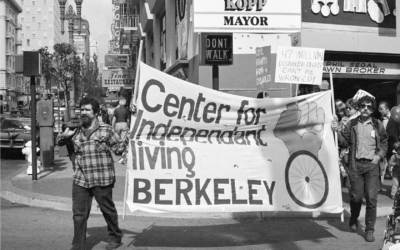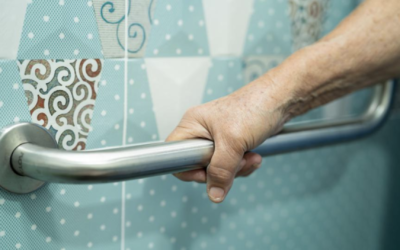The Center for People With Disabilities (CPWD) is a Center for Independent Living with a mission to assist all people with any disability in overcoming barriers to Independent Living. Many of the barriers people with disabilities face are either directly or indirectly a result of marginalization and discrimination. For example, a barrier could be as simple as stairs instead of a ramp that prevents someone from entering a building, or as complex as social attitudes about people with disabilities that lead to business owners hiring more “able-looking” people and a slew of other forms of discrimination. These kinds of behaviors contribute to a phenomenon called systemic oppression. Basically, this means that the dominant thoughts, beliefs, behaviors, and the social systems in place, lead to marginalization, discrimination, and the oppression of a group of people.
We see this with people with disabilities, and we see this with BIPOC people and other non-mainstream groups in our society. Because of this, CPWD stands in solidarity with Black Lives Matter (BLM) and against the systemic oppression of all groups.
Last week, we talked about Intersectionality – how these different groups are connecting in the fight against oppression and in the effort to create more equality, equity, and access. We stated that one of our Core Values in this effort is to have all groups equally represented with an equal voice and equal access.
This week, we delve deeper into the conversation, exploring the roots of systemic oppression, the origins of BLM, and where we are today.
Systemic discrimination heavily impacts the social structure, belief systems, policies, and laws in the U.S. It dates back to slavery and the extermination of the Indigenous peoples of this continent, and is haunted by Jim Crow segregation laws, and wage inequality for women during the industrial revolution that continues to this day. Even with all of the freedoms and opportunities found in American democracy and society, there exits the shadow of a country that was built on conquering and slaughter, enslavement and un- or underpaid workers based on race, class, and gender, and implementation and control of such oppression at the hands of laws and law enforcement.
During the Civil Rights movement in the 1960s, outcry and reaction to systemic oppression exploded with protests and reactions that, for the first time, couldn’t be quietly quelled, and captured the attention of the American public. Much of this was around Black rights, led by Martin Luther King, Jr. and others, as discussed last week (Read the article here).

Black Panther Party members protesting in New York City on April 11, 1969. David Fenton/Getty Images
In 1966, the Black Panther Party was founded and the rallying cry of “Black Power” came to the attention of the nation. Soon the images of raised fists in the air and leather jackets with afros became the signature symbols of this branch of the Civil Rights Movement. The Black Panthers were considered a controversial movement and a threat to public safety by the FBI. However, they also created community programs such as free medical clinics in black communities, as well as free breakfast programs for school children. As we read in our blog post from last week, the Black Panther Party was integral in helping to pass Section 504 of the Rehabilitation Act, which would prevent employment discrimination based on disability. Members of the party not only joined in the month-long sit-in protest in April of 1977, but they also provided hot meals to the protestors.
Their public statement about the protests read, “the issue here is human rights – rights of meaningful employment, of education, of basic human survival – of an oppressed minority, the disabled and handicapped.”
The Black Panther’s involvement in the rights of people with disabilities highlights the significance of recognizing intersectionality. To stand for true human rights is to find common ground free of discrimination in any form for all people. The Black Panther Party officially came to an end in 1982, but their inspiration and influence continue today through BLM and other movements.
The Beginnings of BLM
In 2012, Trayvon Martin, a 17-year-old boy who lived in Florida, was shot and killed by a volunteer neighborhood patrol, George Zimmerman. The police did not initially arrest Zimmerman, and an outcry from the greater community followed. He was then arrested and charged with second-degree murder. At the trial, he was acquitted of all charges.

Protesters hold up signs and a painting of George Floyd during a “Black Lives Matter” protest in front of Borough Hall on June 8, 2020, in New York City. Photo by Angela Weiss/AFP/Getty Images.
In a social media post by community organizer Alicia Garza, she expressed grief over the victim blaming that had taken place and used the term #BlackLivesMatter in her post. This became a rallying cry against racial injustice around the world. After the subsequent police murders of Ahmaud Arbory, Breonna Taylor, and George Floyd, protesters took to the streets, and the BLM movement grew from that single social media post in 2013 to more than 40 chapters worldwide today.
BLM’s goal is to end systemic discrimination and murder, and affirm humanity:
“We affirm the lives of Black queer and trans folks, disabled folks, undocumented folks, folks with records, women, and all Black lives along the gender spectrum. Our network centers those who have been marginalized within Black liberation movements.” [Source: blacklivesmatter.com/about/]
In 2015, the Denver chapter of Black Lives Matter, BLM5280 was founded. The organization demonstrated its commitment to addressing intersectionality by answering a call to activism in October 2016. Much like the Black Panther Party that joined the call for protests for the Rehabilitation Act in 1977, the BLM5280 activists joined the Sioux Nation in South Dakota in protest against the Dakota Access pipeline. As a result of the protests, the pipeline was shut down, marking an achievement in environmental rights not only for the indigenous Sioux people but our planet as a whole. This, once again, demonstrated the power of combined voices standing together for the rights of all. The BLM5280 has gone on to win multiple awards for peacemaking and advocating for human rights.
Systemic Oppression

Tyre Nichols
So why does all this matter today? Discrimination and systemic oppression remain serious problems, which is why BLM has called for the defunding of the police. One glaring example of this is the recent brutal murder of Tyre Nichols on January 7th, 2023. Tyre was beaten to death by five police officers in Memphis after being pulled over for reckless driving. Bodycam footage showed the 29-year-old man being held and beaten, completely unarmed and asking for help. Police said he had been combative, but the bodycam footage did not corroborate their story. In fact, they now have shown there was no evidence substantiating he had even been driving recklessly in the first place.
The shocking thing that we didn’t hear much about in the press is that all five of those police officers were also black. This is a blatant demonstration of how the system itself has become the oppressor.
As John A. Powell, a professor of law, African American, and ethnic studies at UC Berkeley said, “police officers, whatever their color, belong to a system that discriminates by race while incentivizing the over-policing and under-protecting of the Black community. If the police happen to be Black, it actually helps conceal the racist workings of the institution.”
So here we are 67 years after the Black Panther Party was founded, still fighting the fight against systemic oppression. We have seen much progress over the years, but still face discrimination against BIPOC, women, people with disabilities, and the LGBTQI community. As our melting-pot nation grows and becomes more diverse, the topic of discrimination continues to expand. The Center for People with Disabilities stands with BLM and all others in the fight to bring equality, awareness, and education around the topic of discrimination and continue to strive for freedom, peace, and equality for all.
From this mission to educate, next week in our blog we will explore the role of the Civil Rights movement in the history of the Independent Living Movement and how we see this expanding today.





